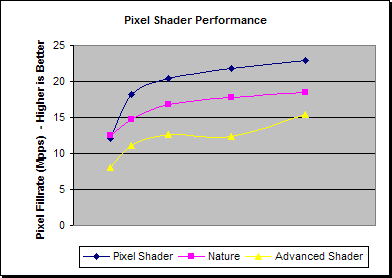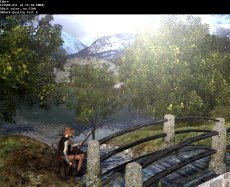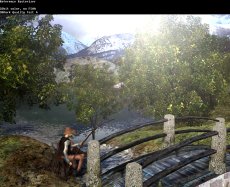Pixel Shaders
Lets take a look at the Pixel Shader performance of the Xabre 400 using 3DMark2001SE's Pixel Shader tests.
| 640x480 | 800x600 | 1024x768 | 1280x1024 | 1600x1200 | |
| Pixel Shader | 39.2 | 38.0 | 25.9 | 16.6 | 11.9 |
| Nature | 40.7 | 30.8 | 21.4 | 13.6 | 9.6 |
| Advanced Shader | 26.2 | 23.2 | 16.1 | 9.4 | 8.0 |
The Pixel Shading performance appears to be quite low, certainly when compared against boards of a similar specification and market point. As we've seen in a few other cases, there appears to be a performance jump at 1600x1200 in the Advanced Shader test for some inexplicable reason.
The actual quality of the Pixel Shader output on the Xabre 400, on these drivers, appears to be pretty good, closely resembling that of the reference image.
Further Tests
Stencil Test (FableMark)
Here we'll check out the performance of Xabre 400 using PowerVR's FableMark benchmark, which is useful for testing Stencil Buffer rendering performance.
| 640x480 | 800x600 | 1024x768 | 1280x1024 | 1600x1200 | |
| FPS | 22.5 | 14.7 | 9.2 | 5.5 | 3.8 |
This benchmark is reasonably tough, especially for a low end board. The Xabre is showing about half the performance of other similarly spec'ed boards.
Overdraw Reduction
First we'll check out the performance of Xabre 400 under PowerVR's VillageMark demo.
| 640x480 | 800x600 | 1024x768 | 1280x1024 | 1600x1200 | |
| FPS | 161 | 155 | 113 | 73 | 51 |
In actual fact the performance here is reasonably impressive, and could indicate that there is actually some Z optimisations and/or overdraw reducing routines in place.
Lets take a look at "Humus"'s GL_EXT_reme benchmark, which has test various different render orders.
| Back-to-Front | Front-to-Back | Random | |
| Overdraw factor 3 | 207.7 | 428.59 | 296.65 |
| Overdraw factor 8 | 78.61 | 245.98 | 162.27 |
Here we can see that both Random Order rendering and Front-to-Back rendering are higher performing than Back-to-Front rendering, which indicates that there is indeed some kind of early Z rejection routines operating on the Xabre 400.



